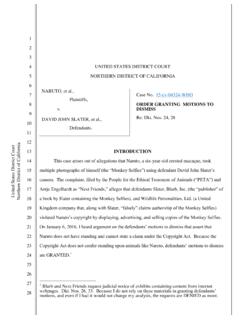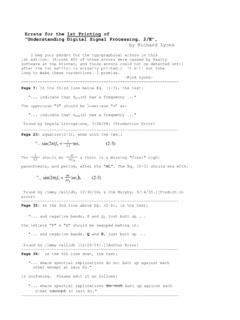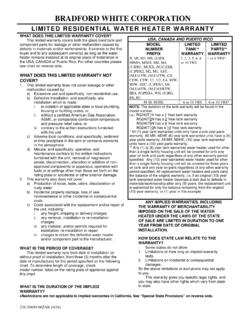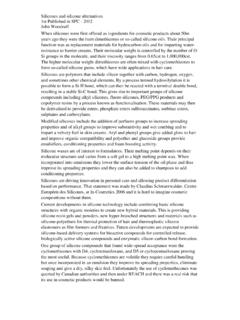Transcription of Hybrid Fluids for Personal Care - s3.amazonaws.com
1 Hybrid Fluids FOR Personal care Headquarters 11 East Steel Road Morrisville, PA 19067 Phone: 215-547-1015 Toll-Free: 888-734-8344 Fax: 215-547-2484 Email: Website: 2019 Gelest, Inc. Hybrid Fluids for Personal care Hybrid Fluids combine the properties of Organic materials with Siloxanes in order to create structures that: Achieve unique skin feel Improve wear properties Improve solubility Lower surface tension Introduce a dimethicone slip with a light natural feel Allow greater formulation latitude Improve perfume retention Enhance dispersion of pigments and fllers Offer compatibility with natural cosmetic ingredients GELEST OFFERS TWO CLASSES OF Hybrid Fluids .
2 SiBrid Fluids Organic modifed siloxanes that cross the boundaries between organics and silicones. SiBrid fuids are soluble in most organics and silicones. Vertasil Fluids High natural product content derived silicones. Vertasil fuids are natural products modifed by incorporation of oligomeric siloxanes that offer reduced surface tension, increased spreadability and enhanced compatibility. 1 Technical Background Hybrid Fluids Siloxane Polymerization Chain Growth Step Growth Ring Opening Polymerization Condensation or Addition Polymerization Living Anionic Polymerization Other Cationic Acid Catalyst Anionic Base Catalyst Anionic Base Catalyst Cationic Acid Catalyst A variety of technologies are employed by Gelest to combine natural and organic functionality with siloxane
3 Structures to form new Hybrid polymer architectures. The introduction of natural or organic components into siloxanes usually constitutes initiation, termination, graft copolymer and block polymerization methods. The natural and organic hybrids discussed throughout this brochure represent materials which have been shown to have both utility and impact in cosmetic formulations. In another sense, these materials are simply examples of the possibilities this technology platform offers for innovation. Hybrid Fluids extend the range of organic and natural products by introducing alternating silicon and oxygen bond segments into their structure.
4 The alternating silicon-oxygen segments have exceptionally low barriers to rotation leading to molecular fexibility. The result is that the desirable characteristics of organic and natural products are extended greater emolliency, wider ranges of liquid behavior and broader formulation options. The ability of Hybrid Fluids to cross compatibility barriers not only allows them direct applicability in both organic and silicone formulations but allows them to act as co-compatibilizing additives. A useful illustration to distinguish the difference of pure organic systems with siloxane systems is to consider the differences between polyisobutylene and polydimethylsiloxane.
5 The molecular scaffold of polyisobutylene is constrained by the rotational barrier of the carbon-carbon bond, kcal/mole, while the molecular scaffold of polydimethylsiloxane is essentially unconstrained since the rotational barrier of the silicon-oxygen bond is essentially zero. The carbon-carbon bond is also shorter than the silicon-oxygen bond, resulting in more tightly packed molecular structures for pure organics. Among other effects, siloxanes allow permeation of moisture and oxygen. At the same time, the strength of the silicon-oxygen bond is greater than the strength of the carbon-carbon bond.
6 Hydrocarbon polydimethylsiloxane Property form amorphous amorphous glass transition, Tg -70 -123 viscosity, n=10 570 cSt 5 cSt viscosity, n=100 5,000,000 cSt 140 cSt surface tension 33mN/m3 22mN/m3 oxygen permeability cm3 -cm/cm2 s cmHg 60 cm3-cm/cm2 s cmHg These fundamental differences in properties of siloxanes compared to hydrocarbons offer advantages in product formulations due to: Low Surface Energy Wide viscosity range Spreading behavior Lower Reactivity Biocompatibility UV-resistance Modifed Hydrophilic-Lipophilic Balance 2 SiBrid Hydrocarbon Hybrids SiBrid Fluids are organic-modifed siloxanes that cross the boundaries between organics and
7 Silicones. SiBrid Fluids are soluble in most organics and silicones. Diethicone Polydiethylsiloxane (INCI name) Diethicone compared to Dimethicone* Diethicone Dimethicone Surface Tension 25-28 mN/m 20-22 mN/m Glass Transition, Tg -139 C -121 C Refractive Index Viscosity Full Range Full Range Organic Compatibility Wide Range Slight * Typical properties for fuids in the viscosity range of 10-500 cSt. PolydiEthylsiloxanes (Diethicones) are the frst of formulation with common cosmetic raw materials a series of Hybrid silicone polymers without methyl including many hydrocarbons, esters, waxes and substitution.
8 Analogous in structure to Dimethicones, surfactants. Diethicones overcome the solubility the fexible polymer structure of Diethicones allows the limitations of Dimethicones with many surfactants, manufacture of a wide range of fuid viscosities. The emollient oils and both natural and synthetic waxes. benefcial properties of Diethicones include excellent Diethicones, in contrast to Dimethicones, wet spreading, gas permeability, water resistance, pigments well. The greater organic character of lubricity and the ability to reduce tack.
9 Diethicone s Diethicones allows coated pigments and fllers tactile properties include a dry feel similar to that to disperse more readily in organic vehicles allowing of Dimethicone but with increased cushion. either higher pigment volume concentration Diethicones have dramatically broad compatibility at equivalent formulation viscosities or substantially with organics compared to Dimethicones, allowing lower viscosities at equivalent pigment loadings. Diethicone - Pigment Wetting Color Grind Viscosity Pigment Wetting Diethicone compared to Dimethicone 55% TiO Sl 2 50% TiO AS2 40% Red 7 (methicone treated) (C silane treated) 8(untreated) Dimethicone DMS-T15 50 cst 8790 cps (3 passes) >30,000 cps (3 passes) 40 cps (5 passes) Diethicone DE-15 50 cst 59 cps (3 passes) 552 cps (2 passes) 25 cps (3 passes)
10 Diethicone Physical Properties polydiethylsiloxane [63148-61-8] Viscosity Density Refractive Flashpoint Molecular Index Weight SiBrid DE-12 15-20 cSt 125 400-500 SiBrid DE-15 40-50 cSt 170 500-800 SiBrid DE-23 250-350 cSt 250 1300-2000 DE-12 DE-15 DE-23 VISCOSITy 3 LIGHT, DRy FEEL EMOLLIENCE, CUSHION SUBSTANTIVITY



















